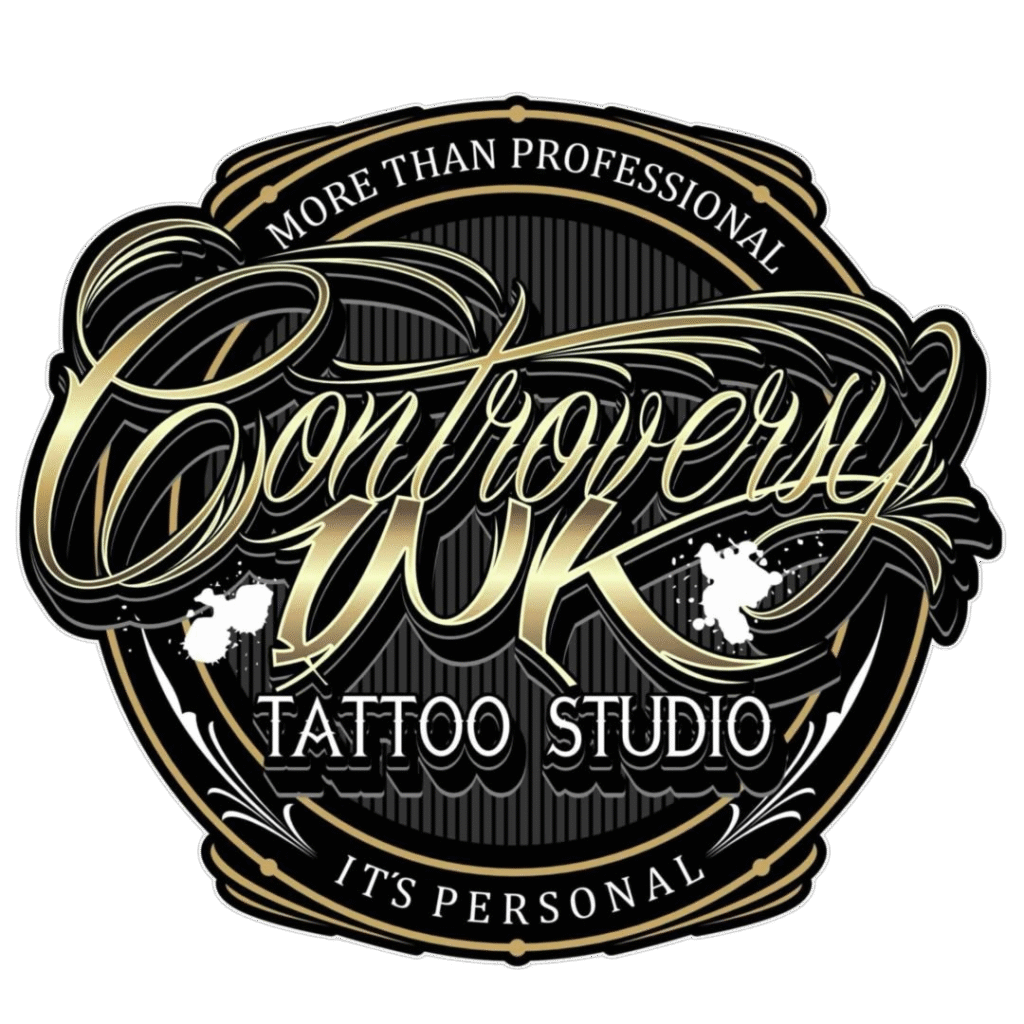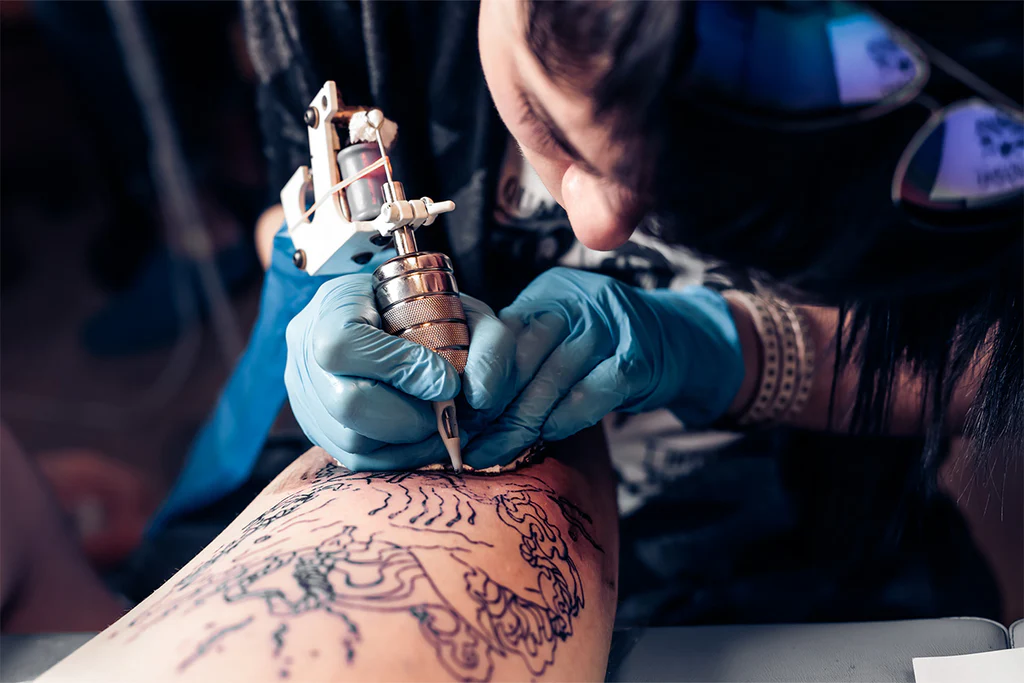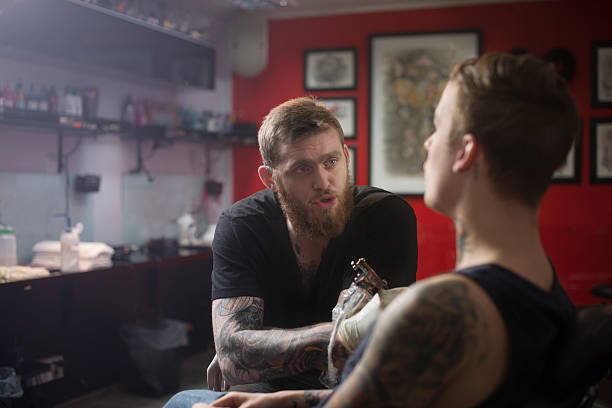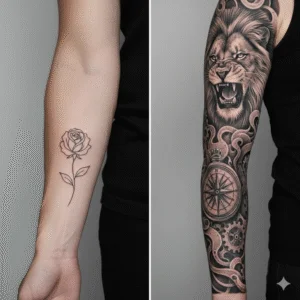Viking tattoos transport you through time, connecting ancient Norse mythology with modern ink artistry. These powerful symbols of prowess, bravery, and divine connection offer a canvas where myth and reality beautifully intersect. Every stroke tells a story of fearless warriors and seafarers, allowing you to carry their timeless narratives on your skin.
When you choose a Viking tattoo, you’re not just selecting a design—you’re embracing symbols rich with meaning and history. The Aegishjalmur (Helm of Awe), for instance, represents protection and conquest, serving as a personal shield against adversaries. Each symbol becomes your own amulet, merging ancient wisdom with contemporary expression.
Join us as we voyage through the fascinating universe of Viking tattoo symbolism, where gods, giants, and mythical realms come alive through intricate designs that have captivated tattoo enthusiasts across the ages.
The Historical Significance Of Viking Tattoos
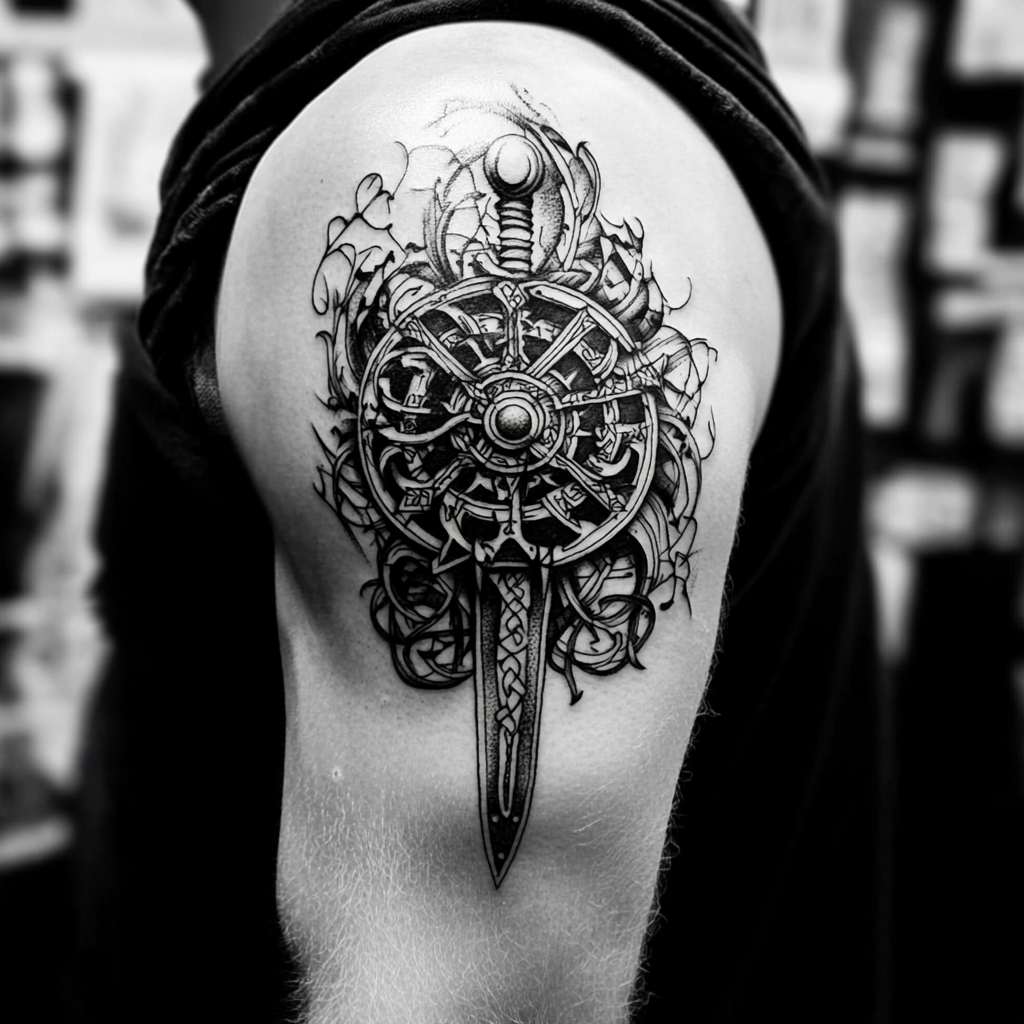
What Ancient Evidence Tells Us
The historical record of Viking tattoos comes primarily from firsthand accounts by observers who encountered Norse peoples during the Viking Age. The most compelling evidence comes from Arab diplomat Ibn Fadlan, who documented his interactions with Viking tribes along the Volga River around 922 CE. In his detailed observations, he described how these warriors were “tattooed from fingertip to neck with dark green or blue-black trees, figures, and various designs.” This account provides the strongest historical indication that Vikings adorned their bodies with permanent markings.
Archaeological findings further support the possibility of Viking tattoo practices. Excavations in Denmark have uncovered tools dating back to the Bronze Age that resemble tattoo needles, suggesting a long-standing tradition of body modification in Nordic cultures. However, the fragile nature of human skin means that direct physical evidence rarely survives in burial sites, leaving us with an incomplete picture of how widespread these practices truly were.
Viking Body Art Practices
Viking tattoos likely served multiple purposes within Norse society, functioning as status symbols, spiritual protection, and tribal identification. The intricate designs described by Ibn Fadlan suggest that Viking tattoos weren’t merely decorative but carried deep cultural significance. These markings may have signified a warrior’s achievements, lineage, or devotion to specific Norse gods.
The process of creating Viking tattoos would have involved techniques quite different from modern methods. Using natural pigments derived from charcoal, ash, and plant materials, Viking tattoo artists would have employed bone needles to puncture the skin and insert the coloring agents. Recent Danish archaeological research has revealed that Vikings favored a color palette ranging from rich reds and bright yellows to earthy greens and browns, which likely extended to their body art as well.
While there’s no conclusive proof that all Vikings wore tattoos, the available evidence strongly suggests that body markings were an important aspect of Norse culture. For many contemporary enthusiasts, Viking tattoos represent a connection to this ancient tradition—a way to honor the bold spirit and rich mythology of the Norse peoples through meaningful symbols and designs etched permanently on the skin.
Popular Norse Symbols For Viking Tattoos
Viking tattoos have surged in popularity as people seek meaningful body art that connects them to ancient traditions and powerful symbolism. These Norse-inspired designs offer both aesthetic appeal and deep cultural significance.
The Valknut: Symbol Of Fallen Warriors

The Valknut stands as one of the most mystical and powerful Viking tattoo symbols available. Consisting of three interlocking triangles, this ancient design is directly associated with Odin and represents the transition between life and death. Archaeologists have discovered the Valknut on numerous rune stones and artifacts from Viking ships, confirming its historical significance. The name itself derives from the Norse words “valr” (fallen warriors) and “knut” (knot), making it a profound choice for those honoring lost loved ones or symbolizing personal transformation. When inked on your skin, the Valknut serves as a stark reminder of mortality while connecting you to the warrior spirit of the Norse people.
Mjölnir: Thor’s Hammer

Mjölnir tattoos represent more than just the weapon of the thunder god Thor—they embody protection, strength, and righteous power. As perhaps the most recognizable Viking symbol, Thor’s hammer stands as a beacon of strength that safeguards the wearer against adversity. In ancient times, Mjölnir pendants were worn as protective amulets, and today, this tradition continues through tattoo art. The hammer’s dual symbolism of both destructive force and protective might makes it particularly appealing for those seeking a Viking tattoo that balances power with purpose. Whether rendered in a traditional style or with modern artistic interpretations, a Mjölnir tattoo declares your unyielding resolve and capacity to defend what matters most.
Yggdrasil: The Tree Of Life

Yggdrasil tattoos capture the cosmic interconnectivity at the heart of Norse mythology. This immense world tree connects the nine realms of existence, making it a powerful symbol of universal harmony and eternal cycles. As a tattoo, Yggdrasil represents the continuous flow of creation, preservation, and destruction that governs all life. Its roots extend to different worlds, including Asgard (realm of gods) and Hel (realm of the dead), symbolizing how all aspects of existence are ultimately connected. When you choose an Yggdrasil design for your Viking tattoo, you’re embracing a profound reminder of life’s cyclical nature and your own place within the cosmos. The intricate branches and roots also provide tattoo artists with endless creative possibilities for personalized designs.
Vegvísir: The Viking Compass
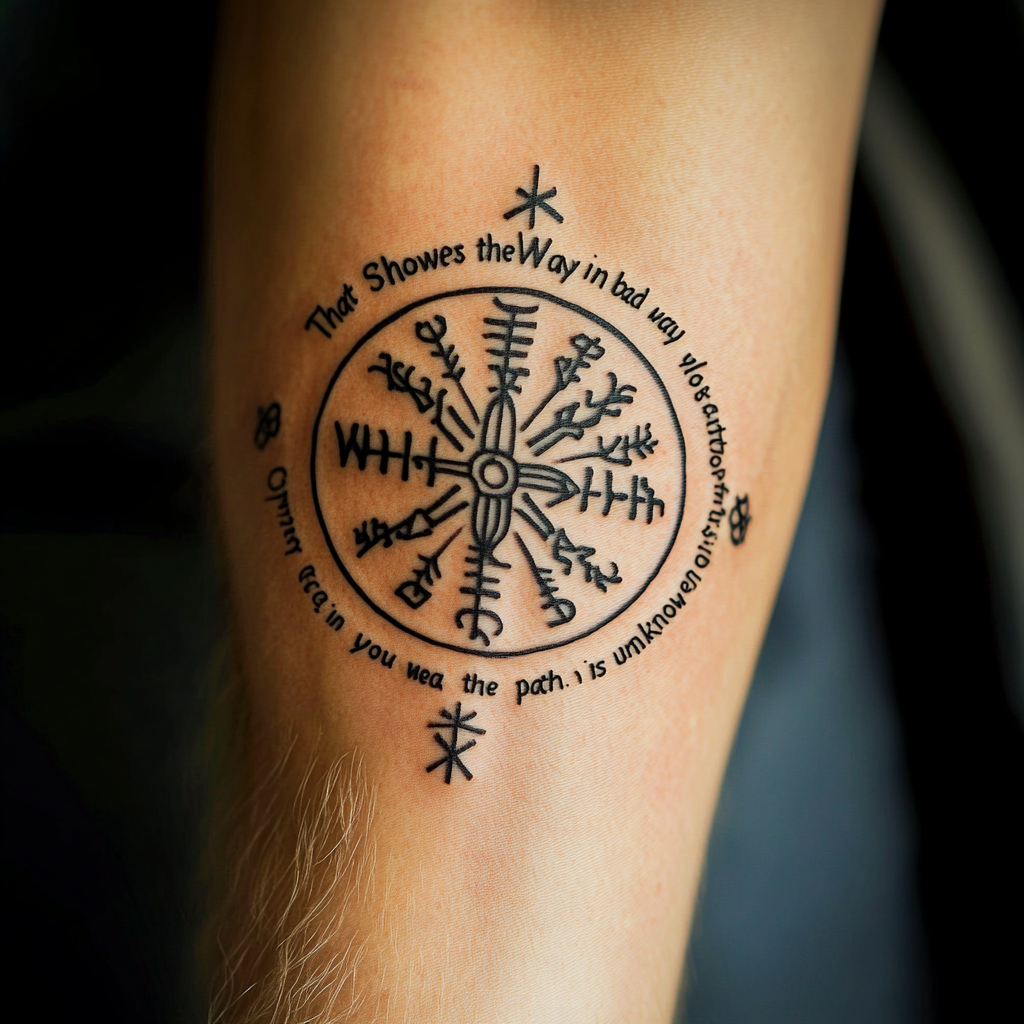
The Vegvísir, often called “That Which Shows the Way,” offers guidance and protection in your life journey. This eight-armed symbol resembles a compass and according to the Huld manuscript, it ensures you’ll “never lose your way in storms or bad weather, even when the path is unknown.” Though technically from later Icelandic magical tradition rather than the Viking Age proper, the Vegvísir has become a staple in modern Viking tattoo designs. Its protective qualities make it particularly appealing for those navigating difficult life transitions or seeking direction. As a tattoo, the Vegvísir can be adapted to various styles and combined with other Norse symbols like Yggdrasil or ravens for a more complex design that tells your personal story while connecting you to ancient Nordic wisdom.
Mythological Elements In Viking Tattoo Designs
Norse mythology forms the backbone of authentic Viking tattoos, offering a rich tapestry of stories and symbols that continue to captivate modern tattoo enthusiasts. These mythological elements connect wearers to the ancient Norse worldview and provide powerful personal meaning.
Gods And Deities
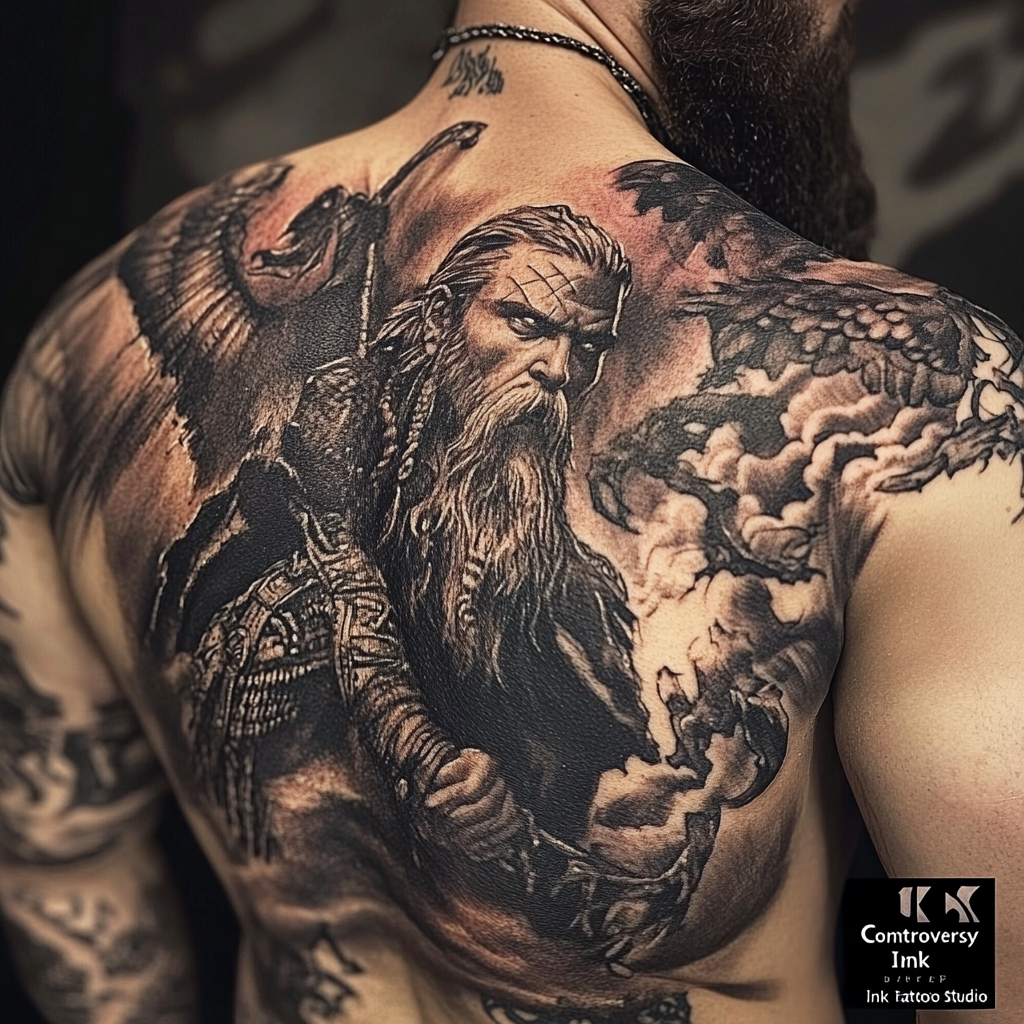
Viking tattoos featuring Norse gods and deities serve as powerful tributes to these ancient figures and their distinctive attributes. Odin, the All-Father and god of wisdom, war, and death, makes for an impressive tattoo design, often depicted with his ravens Huginn and Muninn or sacrificing his eye at Mimir’s well. Many tattoo enthusiasts choose Odin to symbolize the pursuit of knowledge and self-sacrifice.
Thor, with his mighty hammer Mjölnir, represents strength, protection, and thunder in Viking tattoo designs. As one of the most recognized Norse gods, Thor tattoos convey power and the ability to overcome obstacles. The visual imagery often includes Thor wielding Mjölnir amid lightning strikes, creating a dynamic and powerful aesthetic on the skin.
Freya, goddess of love, fertility, and battle, offers a compelling choice for Viking tattoos, especially for women seeking to embody feminine strength and beauty. Tattoo designs often portray Freya with her necklace Brísingamen or riding her chariot pulled by cats, symbolizing independence and the multifaceted nature of femininity in Norse culture.
Loki, the trickster god, provides a fascinating subject for those drawn to complexity and duality in their Viking tattoos. His ability to shapeshift and his role as both helper and antagonist to the other gods makes for intriguing tattoo symbolism representing transformation and the acceptance of life’s contradictions.
Creatures And Beasts

Mythical creatures from Norse legends create striking Viking tattoo designs rich with symbolic meaning. Jörmungandr, the Midgard Serpent that encircles the world, makes for an impressive tattoo, often designed to wrap around arms, legs, or the entire torso. This world serpent represents the cycle of life and death, with its tail in its mouth symbolizing eternity.
Fenrir, the monstrous wolf destined to kill Odin during Ragnarök, embodies raw power and untamed nature in Viking tattoo art. Tattoo designs featuring this fearsome beast often symbolize strength, the breaking of bonds, and facing one’s destiny, making it popular among those who identify with rebellion and personal freedom.
Dragons and serpents feature prominently in Viking art and translate beautifully to tattoo designs. Unlike the fire-breathing dragons of other cultures, Norse dragons like Níðhöggr, who gnaws at the roots of Yggdrasil, represent destructive forces and the constant threat to cosmic order. These creatures make for visually striking tattoos with their intricate, intertwining forms.
Sleipnir, Odin’s eight-legged horse, offers a unique mythological element for Viking tattoos. As a creature that could travel between the worlds of the living and the dead, Sleipnir tattoos symbolize the journey between realms, spiritual transcendence, and swift movement through life’s obstacles.
Huginn and Muninn, Odin’s ravens representing thought and memory, make for elegant Viking tattoo designs that can be simple or elaborate. These birds, which flew throughout the world gathering information for Odin, symbolize intelligence, awareness, and the quest for knowledge – perfect for those who value wisdom and perception.
Runes And Their Meanings

Runic Viking tattoos connect wearers to an ancient writing system imbued with magical significance. The Elder Futhark, the oldest runic alphabet, consists of 24 characters each carrying specific meanings beyond their phonetic values. Individual rune tattoos like Algiz (protection) or Ehwaz (progress) offer simple yet profound symbolism in minimal design.
Bind runes, which combine two or more runes into a single symbol, create unique Viking tattoo designs with personalized meanings. Traditionally used for magical purposes, bind runes in tattoo form allow for custom symbolism that represents specific intentions or desired qualities, making them deeply personal choices for tattoo enthusiasts.
Runic inscriptions and phrases etched as Viking tattoos serve both decorative and meaningful purposes. Whether spelling out a name, a motto, or a meaningful word in the ancient script, these tattoos connect wearers to the linguistic heritage of the Norse people while creating visually distinctive linear patterns on the skin.
Protection runes like the Vegvísir (Viking compass) and Aegishjalmur (Helm of Awe) have become extremely popular Viking tattoo choices. Though technically from later Icelandic magical traditions rather than the Viking Age proper, these symbols have been embraced by the modern Viking tattoo community for their protective qualities and geometric beauty.
Seasonal and harvest runes make for meaningful Viking tattoos that connect wearers to natural cycles. Runes associated with growth, fertility, and harvest seasons can be incorporated into larger nature-themed designs, representing the deep connection to the natural world that characterized Norse spiritual beliefs and daily life.
Modern Viking Tattoo Styles
Viking tattoos have evolved dramatically from their ancient origins, blending historical symbolism with contemporary artistic techniques. Today’s tattoo artists combine Norse heritage with modern aesthetics to create stunning body art that honors Viking culture while appealing to current trends.
Traditional Norse Patterns
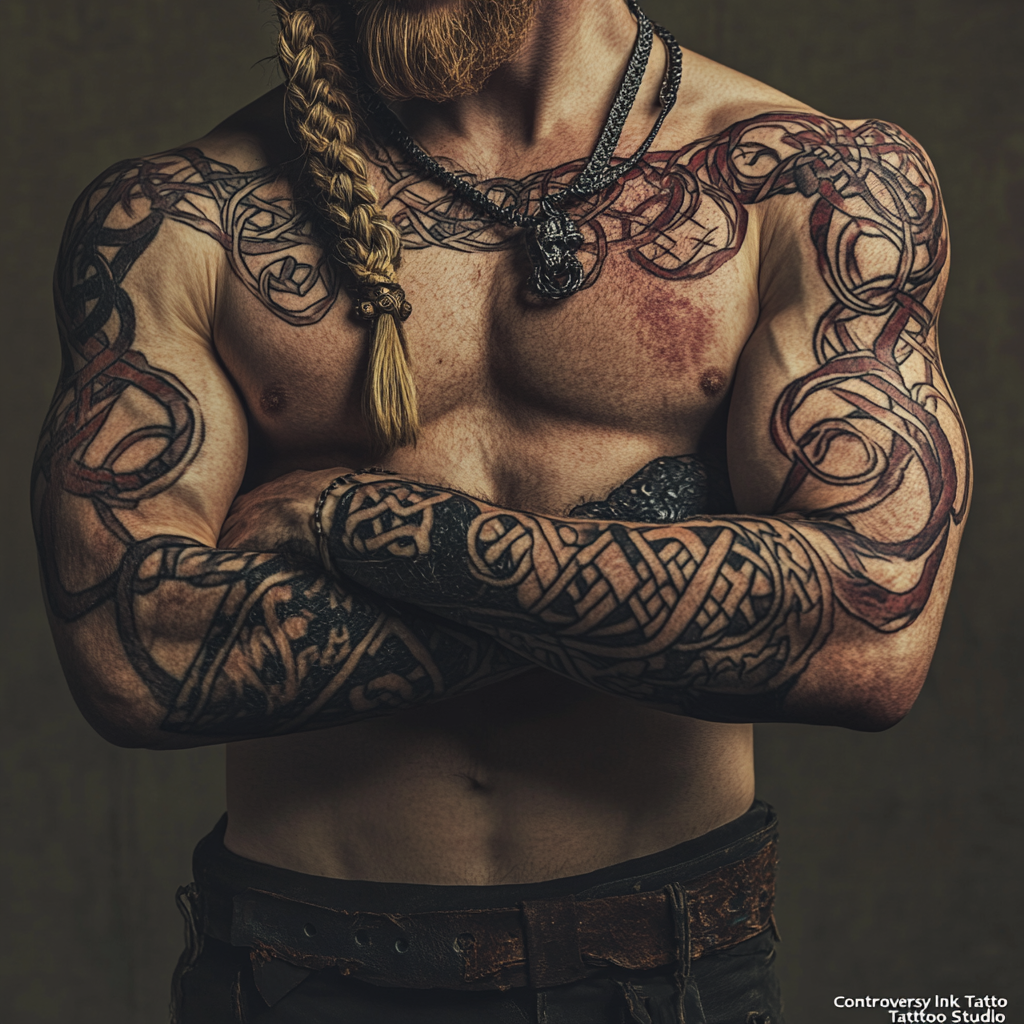
Traditional Norse patterns remain at the heart of Viking tattoo artistry, offering a direct connection to authentic Viking aesthetics. These designs often feature intricate knotwork where lines interweave continuously without beginning or end, symbolizing the interconnectedness of life and death. Celtic-inspired patterns are particularly popular, with their elaborate braids and loops creating mesmerizing visual effects that flow beautifully across the skin.
The appeal of traditional Norse patterns lies in their timeless nature – these designs have maintained their visual impact for over a thousand years. When incorporated into Viking tattoos, these patterns often serve as borders or backgrounds for larger pieces, creating texture and depth. The geometric precision of these designs makes them versatile for various body placements, from sleeves and chest pieces to more subtle wrist or ankle tattoos.
Contemporary Interpretations

Contemporary Viking tattoo styles blend historical elements with modern artistic approaches, creating fresh interpretations that resonate with today’s tattoo enthusiasts. Modern Viking tattoos often feature hyper-realistic portraits of warriors, detailed ship scenes, or vivid depictions of Norse gods with dramatic lighting and dimensional effects that weren’t possible with ancient tattooing techniques. These contemporary designs frequently incorporate elements from popular culture’s portrayal of Vikings, influenced by movies, TV shows, and video games.
Many artists now combine Viking symbols with other tattoo styles like watercolor backgrounds, geometric shapes, or abstract elements. This fusion creates unique pieces that honor Norse heritage while reflecting personal style. Color palettes have also evolved beyond what was historically available, with artists using vibrant hues and subtle gradients to bring Viking imagery to life. These contemporary interpretations make Viking tattoos accessible to those who appreciate Norse mythology but want something that feels relevant to modern aesthetics.
Blackwork And Dotwork Techniques

Blackwork and dotwork techniques have revolutionized Viking tattoo art, offering striking visual impact through the strategic use of negative space and textural elements. Blackwork Viking tattoos feature bold, solid black designs with clean lines that create powerful silhouettes of Norse symbols, gods, or legendary creatures. This technique is particularly effective for creating shadow-like representations of Odin’s ravens, wolves, or imposing Viking longships.
Dotwork Viking tattoos employ thousands of tiny dots to create shading, depth, and texture, giving ancient symbols like the Vegvísir or Yggdrasil a contemporary feel while maintaining their historical significance. This meticulous technique allows for extraordinary detail and a distinctive visual texture that ages well over time. The gradient effects possible with dotwork are ideal for creating atmospheric Viking scenes that appear to emerge from the skin, giving the impression of ancient runes or carvings coming to life. This technique particularly suits designs featuring runic inscriptions or intricate Helm of Awe patterns, where the stippled texture evokes the weathered appearance of ancient artifacts.
Placement Ideas For Viking Tattoos
The placement of your Viking tattoo is as significant as the symbol itself, creating a powerful connection between the Norse imagery and your body canvas. Each location tells a different story and enhances the symbolism in unique ways.
Full Sleeve Norse Designs

Full sleeve Viking tattoos transform your arm into an epic Norse saga. The arm symbolizes strength and might, making it the perfect canvas for symbols like Mjolnir (Thor’s Hammer) or the Helm of Awe. These powerful emblems of protection and courage come alive when wrapped around your bicep or extending down your forearm.
A full sleeve allows for intricate storytelling, where you can incorporate multiple elements such as Norse gods, mythical creatures, and runic inscriptions flowing together. The continuous design creates a visual journey from shoulder to wrist, mimicking the sprawling nature of Norse mythology itself. Consider including elements like Odin’s ravens, dragon-headed longships, or intricate Celtic-inspired knotwork that winds throughout the sleeve.
The forearm portion of your sleeve remains visible even in professional settings with rolled-up sleeves, making it ideal for meaningful runes or smaller symbols you want to display regularly. The upper arm section can feature larger, more dramatic scenes like battles or depictions of Valhalla, creating a personal mythological narrative that encircles your arm.
Chest And Back Pieces

The chest offers a deeply personal placement for Viking tattoos, positioning powerful symbols close to your heart. This location is ideal for meaningful designs like the Valknut (associated with Odin and the afterlife) or personal runic messages that hold special significance. The flat, broad canvas of the chest allows for symmetrical designs or centered pieces that make a bold statement.
Back tattoos provide the most expansive canvas for elaborate Viking designs. The broad space allows for intricate detailing and the creation of larger epic Norse tales. The Yggdrasil (World Tree), with its extensive branches and roots connecting various realms, perfectly suits this location, symbolizing the interconnectedness of all existence. Similarly, a Viking longship spanning across your shoulders can represent exploration and adventure, core values of Norse culture.
The spine area creates a natural vertical axis for designs like a standing Mjolnir or a column of meaningful runes. For maximum impact, consider a full back piece that tells a complete story—perhaps depicting gods like Thor or Odin in battle, surrounded by symbolic elements that hold personal significance. These larger pieces allow for exceptional detail and shading, creating truly breathtaking Norse-inspired artwork.
Smaller Symbolic Placements

Not all Viking tattoos need to be expansive pieces. Smaller, strategic placements can be equally powerful and meaningful. The wrist or inner forearm makes an excellent location for runic inscriptions or a compact Vegvísir (Viking compass). These more discreet placements allow you to carry Norse protection symbols with you always, visible when you choose but easily covered when necessary.
The side of the ribcage offers a long, narrow canvas perfect for a vertical design like Gungnir (Odin’s spear) or a series of meaningful runes. This more private placement can hold deeply personal symbols or protective Norse emblems that you keep primarily for yourself rather than display.
For minimalist enthusiasts, finger tattoos featuring single runes or tiny hammer symbols provide a subtle nod to Norse heritage. Similarly, behind the ear or on the back of the neck allows for small but meaningful Viking symbols that peek out from beneath your hair. These smaller placements are ideal for those wanting to honor Norse traditions without committing to larger pieces, yet they still carry the powerful symbolism that makes Viking tattoos so compelling.
Cultural Considerations When Getting A Viking Tattoo
Avoiding Misappropriation
When choosing Viking tattoos, it’s crucial to approach the tradition with respect and understanding. Norse symbols carry deep cultural significance beyond their aesthetic appeal. Take time to research the authentic historical context of Viking symbols rather than relying on modern interpretations that may be inaccurate or distorted.
Avoid symbols that have been appropriated by hate groups, such as certain variations of the Othala rune, which has unfortunately been co-opted by white supremacist organizations. Being aware of these misappropriations helps ensure your tattoo honors rather than distorts Norse heritage.
Consider consulting with tattoo artists who specialize in Nordic designs and have studied the historical context of Viking symbolism. These artists can guide you toward authentic representations that respect the cultural origins of the symbols while creating a meaningful piece for you.
Understanding The True Meanings
Viking tattoos represent more than just striking imagery—they embody complex belief systems and cultural narratives. The Valknut, with its three interlocking triangles, isn’t simply an attractive geometric design but a powerful symbol connected to Odin and the afterlife. Understanding these deeper meanings transforms your tattoo from mere decoration to a meaningful statement.
Symbols like Mjölnir (Thor’s hammer) carried specific protective meanings for Norse peoples, representing strength and safeguarding against evil. Similarly, the Vegvísir wasn’t just a compass but a profound symbol believed to guide travelers through rough weather—both literally and metaphorically.
Runes, beyond their visual appeal, functioned as both practical writing and magical symbols in Norse culture. Each rune carried specific meanings and powers, and combining them in bind runes created personalized messages or spells. Taking time to understand these nuances ensures your Viking tattoo honors the rich symbolic language of Norse culture rather than simply appropriating its visual elements.
By researching the authentic meanings behind Viking symbols, you connect more deeply with the tattoo you choose and show respect for the cultural heritage these symbols represent. This knowledge transforms your Viking tattoo from a trendy design to a meaningful emblem that resonates with the ancient wisdom and spiritual beliefs of Norse tradition.
Finding The Right Artist For Your Viking Tattoo
Selecting the perfect tattoo artist is crucial for bringing your Viking tattoo vision to life with authenticity and skill.
Specialists In Norse Imagery
Finding an artist who specializes in Norse imagery is essential for creating an authentic Viking tattoo. Look for tattoo artists who demonstrate a deep understanding of Viking symbolism and Norse mythology in their work. These specialists often have extensive knowledge about the historical significance behind symbols like Mjölnir, Yggdrasil, and the Valknut, ensuring your tattoo remains true to Viking heritage. Artists with expertise in Nordic designs can offer valuable insights on how to personalize your tattoo while maintaining its cultural integrity. Research tattoo studios that specifically advertise Norse or Viking specialties, as they’re more likely to employ artists with the right skillset for your Viking tattoo. Many specialists also stay updated on archaeological findings and historical research to ensure their work accurately represents Viking art styles rather than modern misconceptions.
Portfolio Evaluation Tips
When evaluating an artist’s portfolio for your Viking tattoo, focus on the precision of their linework in knotwork patterns and runic symbols. Authentic Viking tattoos often feature intricate details that require steady hands and meticulous attention. Look for consistency in their previous Viking-themed works—do their Mjölnir designs show the same quality as their Yggdrasil renditions? Pay special attention to how they handle shading and depth in Norse symbols, particularly in complex designs like the World Tree or warrior scenes. A strong portfolio should showcase versatility within Viking imagery, from minimalist runic tattoos to elaborate mythological scenes. Also, examine how they incorporate personal elements into traditional designs, as this indicates their ability to customize your tattoo while honoring Viking aesthetics. Don’t hesitate to ask about their knowledge of Norse symbolism during consultations—a true specialist will be able to discuss the meaning behind different Viking tattoo elements and guide you toward choices that resonate with your personal journey while respecting the cultural significance of these powerful symbols.
Caring For Your Viking Tattoo
Healing Process
The healing journey of your Viking tattoo requires the same dedication that ancient Norse warriors showed in battle. During the first 48-72 hours, your tattoo will likely be wrapped in a protective covering that should remain in place as directed by your artist. After removing the covering, gently wash your tattoo with lukewarm water and fragrance-free soap, patting—never rubbing—it dry with a clean paper towel. Apply a thin layer of recommended aftercare ointment to keep the skin hydrated while allowing it to breathe.
For the first two weeks, avoid submerging your tattoo in water, which means no swimming, baths, or hot tubs. Stay away from direct sunlight, tight clothing, and physical activities that might cause excessive sweating. Remember, your Viking tattoo is essentially an open wound during this phase, and proper care now ensures the intricate details of your Norse symbols remain crisp and clear as they heal.
Long-Term Maintenance
Your Viking tattoo represents a connection to Norse mythology and ancient warriors who valued resilience—your aftercare should reflect this same commitment. For long-term maintenance, moisturize your tattoo daily with a fragrance-free lotion to prevent your Viking symbols from fading or becoming distorted. This is particularly important for intricate designs like the Vegvísir or detailed Yggdrasil illustrations.
Sun protection is crucial for preserving the vibrancy of your Viking tattoo, as UV rays cause significant fading over time. Apply a broad-spectrum sunscreen with SPF 30 or higher whenever your tattoo will be exposed to sunlight. Dark pigments, commonly used in traditional Viking tattoos, are especially vulnerable to sun damage. Touch-ups may be necessary every few years to maintain the bold lines and intricate details characteristic of Norse-inspired artwork. By treating your Viking tattoo with the reverence it deserves, you’ll ensure this meaningful piece of body art continues to tell its ancient story for years to come.
Popular Viking Tattoo Combinations
Viking tattoos stand as powerful bridges between ancient Nordic traditions and modern self-expression. By adorning your skin with these meaningful symbols you’re not just following a trend but embracing a rich cultural legacy that spans centuries.
Whether you choose the protective Aegishjalmur the transformative Valknut or intricate runic inscriptions your Viking tattoo becomes a personal talisman that honors Norse heritage while telling your unique story.
Remember that the true value of these designs lies in their authenticity and personal significance. With proper research thoughtful placement and quality artistry your Viking tattoo will serve as a permanent reminder of the warrior spirit that connects us across time – bold enduring and deeply meaningful.
Frequently Asked Questions
What is the significance of Viking tattoos?
Viking tattoos represent more than just artistic designs—they symbolize bravery, protection, and divine connection. These tattoos carry deep historical significance, with each symbol telling stories of Norse mythology and warrior culture. Modern enthusiasts choose Viking tattoos to honor ancient traditions while expressing personal values like strength and courage.
Did Vikings actually have tattoos?
While conclusive proof is limited, historical accounts from Arab diplomat Ibn Fadlan describe Vikings with intricate body markings. Archaeological findings of tools resembling tattoo needles from the Bronze Age suggest Nordic cultures practiced body modification. Though not definitively proven, evidence strongly indicates tattoos were an important aspect of Norse culture.
What are the most popular Viking tattoo symbols?
The most popular symbols include the Valknut (representing fallen warriors), Mjölnir (Thor’s hammer symbolizing protection), Yggdrasil (the Tree of Life), and the Vegvísir (Viking compass for guidance). These symbols have surged in popularity for their combination of aesthetic appeal and profound cultural significance.
How were Viking tattoos traditionally created?
Traditional Viking tattoos were likely created using natural pigments and bone needles. Artists employed a rich color palette derived from natural sources. The process was likely painful and time-consuming, reflecting the wearer’s commitment and endurance—qualities highly valued in Viking culture.
What mythological elements appear in Viking tattoos?
Viking tattoos frequently feature gods like Odin, Thor, Freya, and Loki, each representing unique attributes. Mythical creatures such as Jörmungandr (World Serpent), Fenrir (the wolf), and Sleipnir (Odin’s eight-legged horse) are also popular. These elements connect wearers to the ancient Norse worldview and its rich storytelling traditions.
What role do runes play in Viking tattoos?
Runes serve as powerful elements in Viking tattoos, deriving from the Elder Futhark alphabet. Many enthusiasts incorporate specific runes or bind runes (combined symbols) for personalized meanings. Protection runes like Vegvísir and Aegishjalmur remain especially popular, while seasonal runes connect wearers to natural life cycles.
What modern styles are used for Viking tattoos?
Contemporary Viking tattoos blend traditional symbolism with modern techniques. Styles include traditional Norse patterns with intricate knotwork, hyper-realistic portraits, blackwork designs with bold silhouettes, and dotwork featuring meticulous detail. These approaches make Viking tattoos accessible to today’s enthusiasts while honoring Norse heritage.
Where are Viking tattoos typically placed?
Placement enhances a Viking tattoo’s symbolism. Full sleeves transform arms into Norse mythology narratives, while chest and back pieces provide expansive canvases for intricate storytelling. Smaller placements on wrists or behind ears allow for discreet yet meaningful expressions of Norse heritage. Each location offers unique storytelling opportunities.
Are there cultural considerations when getting a Viking tattoo?
Yes, cultural respect is crucial. Research authentic historical contexts to avoid symbols co-opted by hate groups. Consult with artists specializing in Nordic designs to ensure respectful, accurate representations. Understanding the deeper meanings transforms your tattoo from mere decoration into a meaningful statement honoring rich Norse cultural heritage.
How should I care for my Viking tattoo?
During initial healing, keep your tattoo clean and follow your artist’s aftercare instructions. For long-term maintenance, moisturize daily and protect from sun exposure to preserve vibrancy. Proper care ensures your meaningful Viking tattoo will continue to tell its ancient story for years to come.
